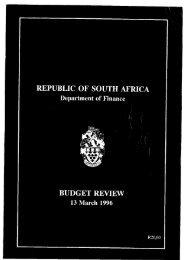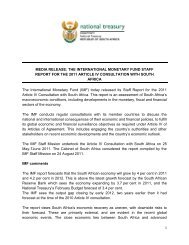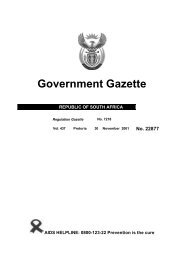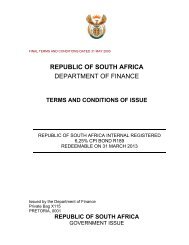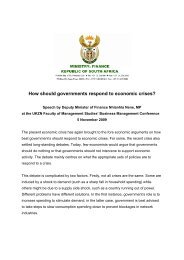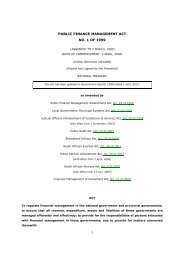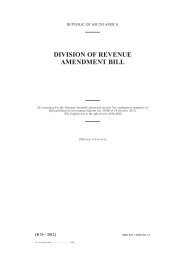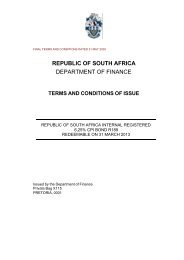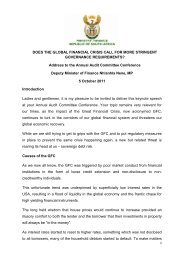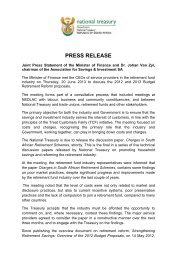1998 SOUTHERN AFRICA ECONOMIC ... - National Treasury
1998 SOUTHERN AFRICA ECONOMIC ... - National Treasury
1998 SOUTHERN AFRICA ECONOMIC ... - National Treasury
You also want an ePaper? Increase the reach of your titles
YUMPU automatically turns print PDFs into web optimized ePapers that Google loves.
S WA Z I L A N D<br />
Recent macro-Economic Developments<br />
For 1997, economic growth is projected to remain at 1996<br />
l eve l s , judging from estimates produced by the Ministry of<br />
Economic Planning and Deve l o p m e n t ,which put growth at 3.8<br />
p e rc e n t .With the re c e n t ly estimated population growth of 3.3<br />
p e rcent per annu m , this state of affairs implies a slight incre a s e<br />
in real GDP per cap i t a ,indicating marginal improvement in the<br />
s t a n d a rd of living of the Swazi people.<br />
The robust economic performance is expected to stem largely<br />
f rom a strong re c ove ry of the agricultural sector and an<br />
expanding manufacturing sector. The good rains re c e i ved since<br />
the beginning of 1996 and throughout 1997, despite concerns of<br />
n e g a t i ve El Nino effe c t s , a re expected to improve agricultural<br />
p ro d u c t i o n .Economic growth during 1997 could have exceeded<br />
the projected grow t h , had it not been for the stay - aw ay in<br />
Fe b r u a ry 1997, which extended over an unprecedented 5<br />
we e k s . The manufacturing sector’s contribution to GDP at<br />
factor cost, i m p roved marginally to 35.7 percent in 1997 fro m<br />
35.1 percent the previous ye a r. H oweve r, the stro n g<br />
p e r formance of this sector has been impaired in recent ye a r s ,a s<br />
a result of a slow d own in fo reign inve s t m e n t s . Since the early<br />
1990s Swaziland’s balance of payments posted an overall surplus<br />
of SZL66.1m (USD15m) in 1996, f rom a surplus of SZL108.2m<br />
(USD30m) in 1995. The financial account, excluding re s e rve s ,<br />
posted yet another net outflow of USD48m in 1996 from an<br />
o u t f l ow of USD44m the year befo re.<br />
The trade account continued to deteriorate during 1996 to<br />
re c o rd a deficit of USD158m from USD135m the year befo re,<br />
as a result of comparative slower growths in exports against<br />
i m p o rt s .<br />
Fo reign direct investment re c o rded a net inflow of USD39m in<br />
1 9 9 6 ,f rom an inflow of USD7m the year befo re. No major new<br />
c apital injections we re re c o rded in 1996, s ave for an increase in<br />
re i nvested earnings, as some companies expanded their<br />
o p e r a t i o n s . The tentative position for 1997 indicates a net<br />
i n f l ow of USD25m.<br />
On the monetary fro n t ,net fo reign assets re g i s t e red an incre a s e<br />
of about 16.7 percent the previous ye a r. E x p o rt pro c e e d s ,<br />
m a i n ly from the manufacturing sector, we re responsible for the<br />
i m p roved position. This increase was also supported by a firmer<br />
lilangeni exchange rate against major trading curre n c i e s ,<br />
p a rt i c u l a r ly during the first half of 1997. The re s e rves re f l e c t e d<br />
3.6 months of the country ’s estimated import cover at the end<br />
of December, the same level as in 1996.<br />
G overnment net credit position with the banking system during<br />
the same period amounted to USD196m, 18.5 percent above<br />
the previous ye a r ’s leve l . The position was supported by<br />
periodic inflows of customs and tax re c e i p t s . C redit to the<br />
private sector rose by 15 percent over the year ended<br />
December 1997.<br />
I n t e rest rates continued to be slightly below those ruling in<br />
South Africa during the year ended December 1997. T h e<br />
general structure of interest rates was revised dow n w a rd 1<br />
p e rcentage point in October 1997 and again early <strong>1998</strong>,<br />
fo l l owing a similar move in South A f r i c a .<br />
Total debt stock stood at USD168m at end March 1997, a n<br />
i n c rease of only 3.5 percent over the ye a r. The increase in the<br />
debt is a result of the continued depreciation of the lilangeni<br />
against some major curre n c i e s ,in which the country ’s debt is<br />
n o m i n a t e d , coupled with disbursements from existing loans<br />
during the course of the ye a r. Total debt service increased in<br />
1 9 9 6 / 1 9 9 7 ,to re c o rd USD21m, f rom USD14m, a year befo re,<br />
l a r g e ly constituted by capital re p ay m e n t s .The country ’s external<br />
debt structure did not change over the year 1996, with the<br />
dominating share still being that of central government at 93<br />
p e rc e n t .<br />
On the fiscal side, an encouraging result was achieved in<br />
1 9 9 6 / 1 9 9 7 . P re l i m i n a ry figures for 1997/98 point tow a rds a<br />
modest estimated surplus of E0.7m<br />
It is encouraging to note that the government has emphasised<br />
the need to intensify the internal structural adjustment<br />
p rogramme started during the 1995/96-budget period. In ord e r<br />
to improve its reve nu e, a new taxation bill that aims at<br />
d i versifying the reve nue base will short ly be tabled in Pa r l i a m e n t<br />
for ap p rov a l .<br />
Financial Institutions<br />
The Central Bank of Swaziland was established as the country ’s<br />
m o n e t a ry authority in April 1974 and assumed its operative<br />
functions in 1979. The mandate of the Bank includes the issue of<br />
c u rre n c y, clearing and settlement of pay m e n t s ,s u p e rvision and<br />
inspectorate of banks, management of re s e rve s , s e rvice and<br />
redemption of domestic debt, administration of exchange<br />
c o n t ro l ,and fo r mulation and implementation of monetary policy.<br />
T h e re are three lending schemes that are operated by the<br />
Central Bank. These consist of the Export Credit Guarantee<br />
S c h e m e, the Small Scale Enterprise Loan Guarantee Scheme and<br />
the Public Enterprise Loan Guarantee Fund. T h e re are<br />
c o m m e rcial banks in Swaziland:First <strong>National</strong> Bank of Swaziland,<br />
S t a n d a rd Bank Swaziland, which acquired Barc l ays Bank on 1<br />
J a nu a ry <strong>1998</strong>, and Nedbank Swaziland (fo r m e r ly Standard<br />
C h a rt e red Bank). T h e re is also one development bank,<br />
Swaziland Development and Savings Bank, and a building society.<br />
C o m m o n ly used securities in the money market include stocks,<br />
t re a s u ry bills, bank acceptances, n e gotiable certificates of<br />
d e p o s i t s .<br />
Swaziland Stock Exchange<br />
In the seve n - year period of its operation Swaziland’s stock<br />
m a r ket has listed the fo l l owing companies; Masterfridge Limited,<br />
The Royal Swaziland Sugar Corporation Ltd,Nedbank Swaziland<br />
L t d , and Swazispa Holdings Limited. The number of listed<br />
companies dropped to four after the de-listing of Lonrho Sugar<br />
L t d , in 1997, hence the fall in the exchange’s marke t<br />
c ap i t a l i s a t i o n .Lonrho Sugar Ltd constituted about 66 percent of<br />
the total market capitalisation prior to de-listing. Due to this,t h e<br />
volume of traded shares in 1997 leaped substantially to ove r<br />
134 m .<br />
85



